I'll tell you what is weird. Five maggots come out of the one mantis. When they eclosed there were six flies in the container. Today there are at least eight. So there must have been more that were inside the dead mantis.
You are using an out of date browser. It may not display this or other websites correctly.
You should upgrade or use an alternative browser.
You should upgrade or use an alternative browser.
Internal parasites
- Thread starter Rick
- Start date

Help Support Mantidforum:
This site may earn a commission from merchant affiliate
links, including eBay, Amazon, and others.
Ntsees
Well-known member
Now it makes me wonder if another larvae will pop out from your other mantid (the one that lived = amazing). You're going to have a nice display, mantids and parasites.I'll tell you what is weird. Five maggots come out of the one mantis. When they eclosed there were six flies in the container. Today there are at least eight. So there must have been more that were inside the dead mantis.
Last edited by a moderator:
In that case I don't think so.Now it makes me wonder if another larvae will pop out from your other mantid (the one that lived = amazing). You're going to have a nice display, mantids and parasites.
MantidLord
Well-known member
Okay, I don't know what the heck is going on, but a mantis that I found a couple of days ago (Iris oratoria) had a parasite come out of her. The only thing is I never saw the maggot but as you can see, she looks similar to the other ones. Can anyone I.D. this because I don't know if it's spreading or what. And Rick, can you get a closer pic of the flies so we can get a size reference? Also, I'm starting to wonder if this thread should be a sticky in health section just because it's so informative and seemingly urgent. I mean, I've had oratorias for years and all of a sudden this one has the parasite.
Hours before parasite came out, seemed sluggish and dying.
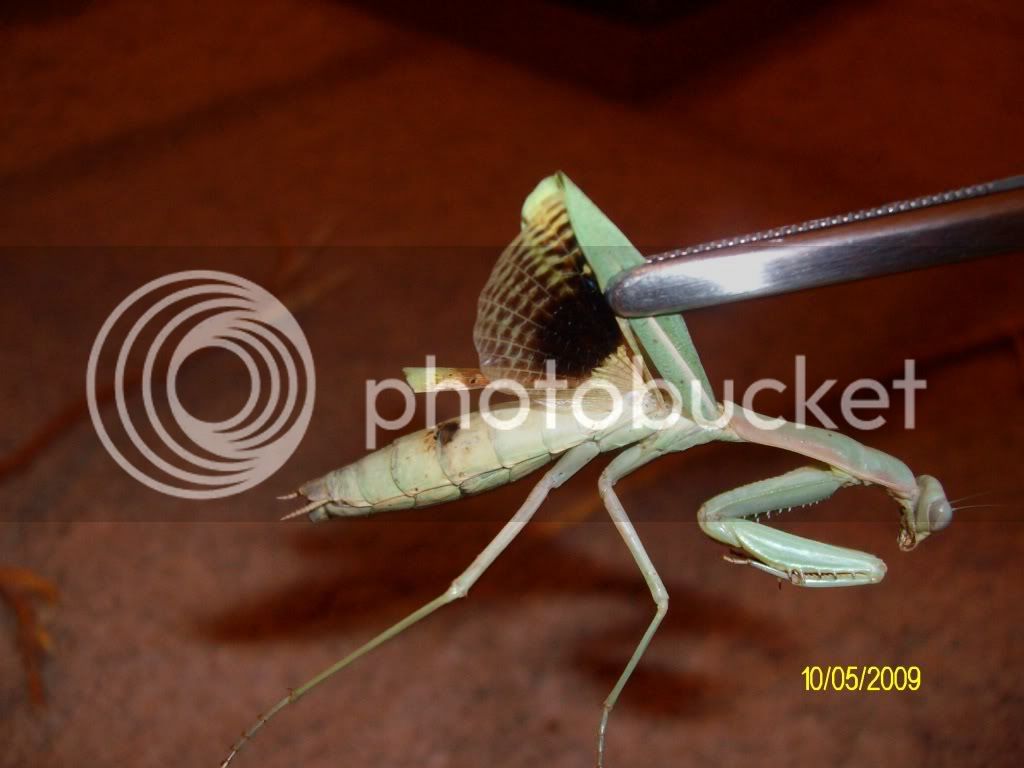
After parasite came out and mantis was still somewhat alive.
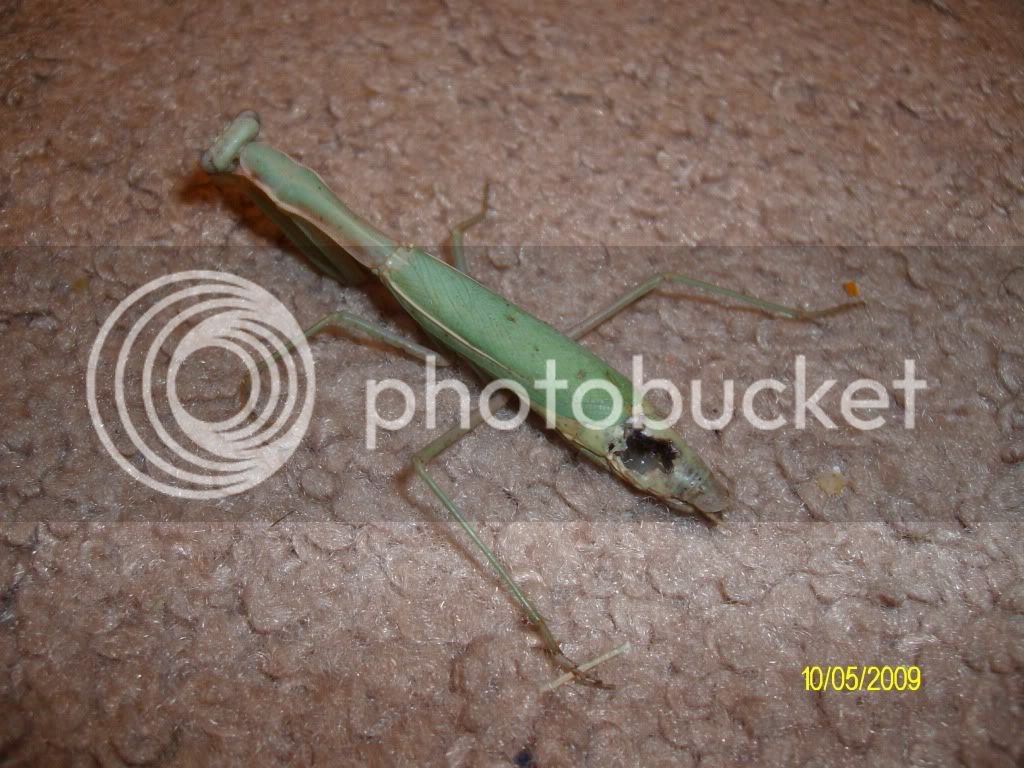
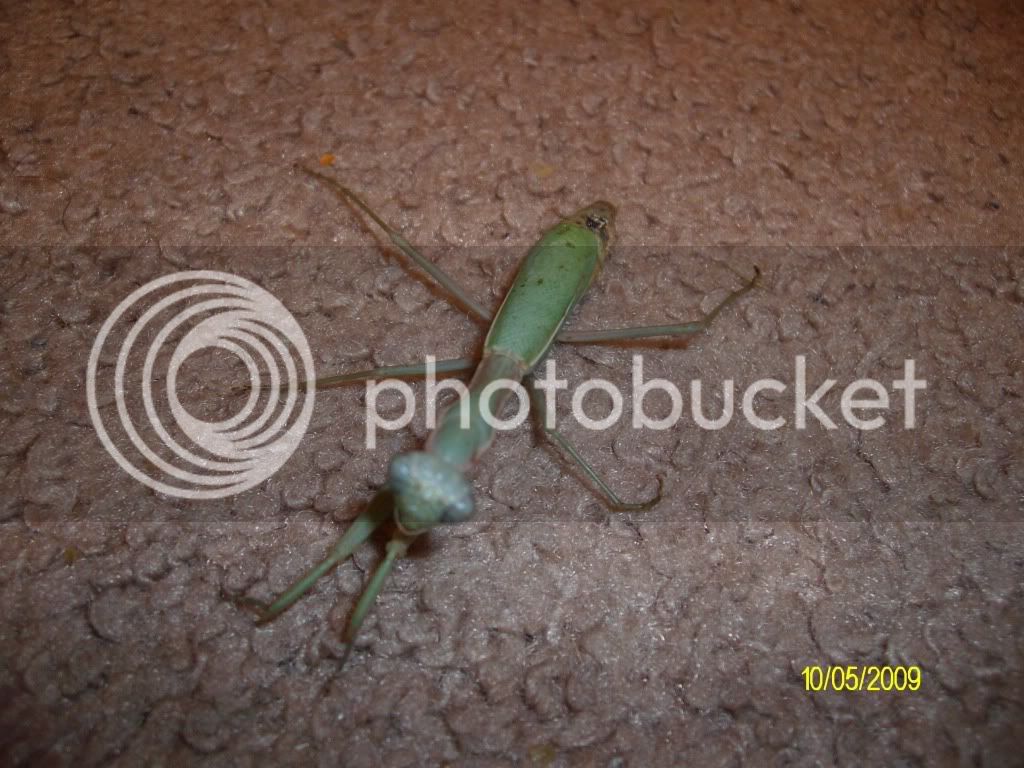
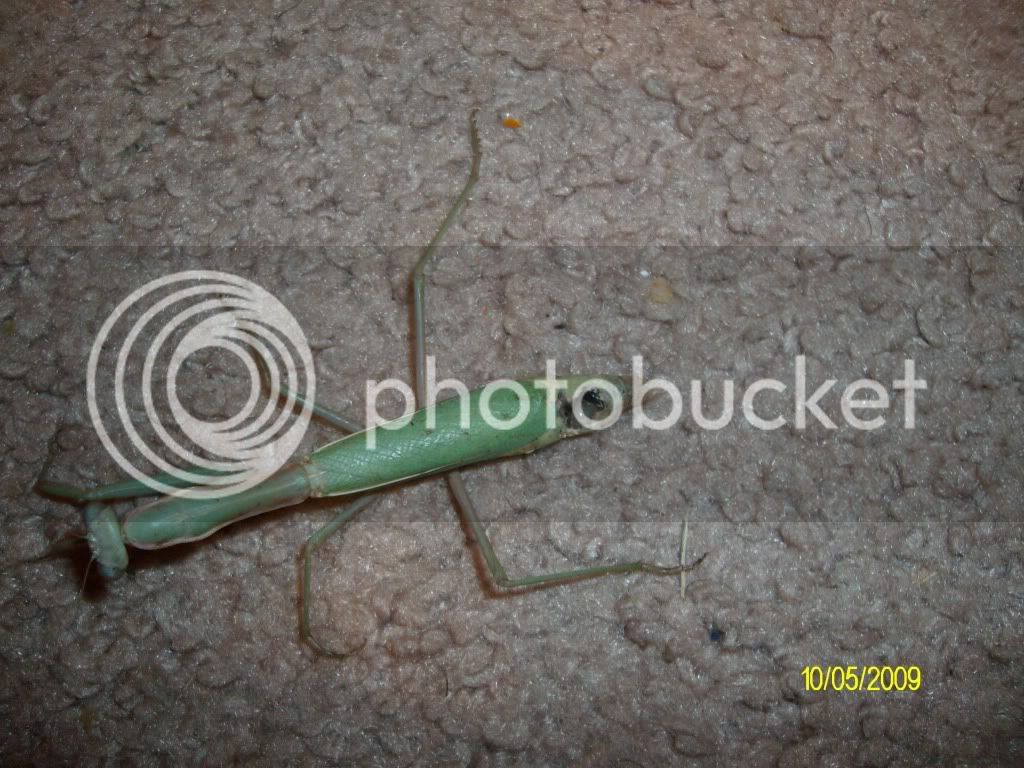

Hours before parasite came out, seemed sluggish and dying.

After parasite came out and mantis was still somewhat alive.




ismart
Well-known member
Where is the parasite that came out of the mantis?
MantidLord
Well-known member
I don't know. I looked inside the container and I couldn't find any maggots or pupae things. All I saw were cricket parts littered here and there. I went back again today and saw nothing.Where is the parasite that came out of the mantis?
Oh and just another side note. That same mantis when I caught it, "laid" two ooths. One was some small thing and the other was this: Obviously different than the standard I. oratoria ooth. This was laid a week before it died. The normal standard ooth (laid by a different female) is on the bottom.
Oops I forgot to upload them
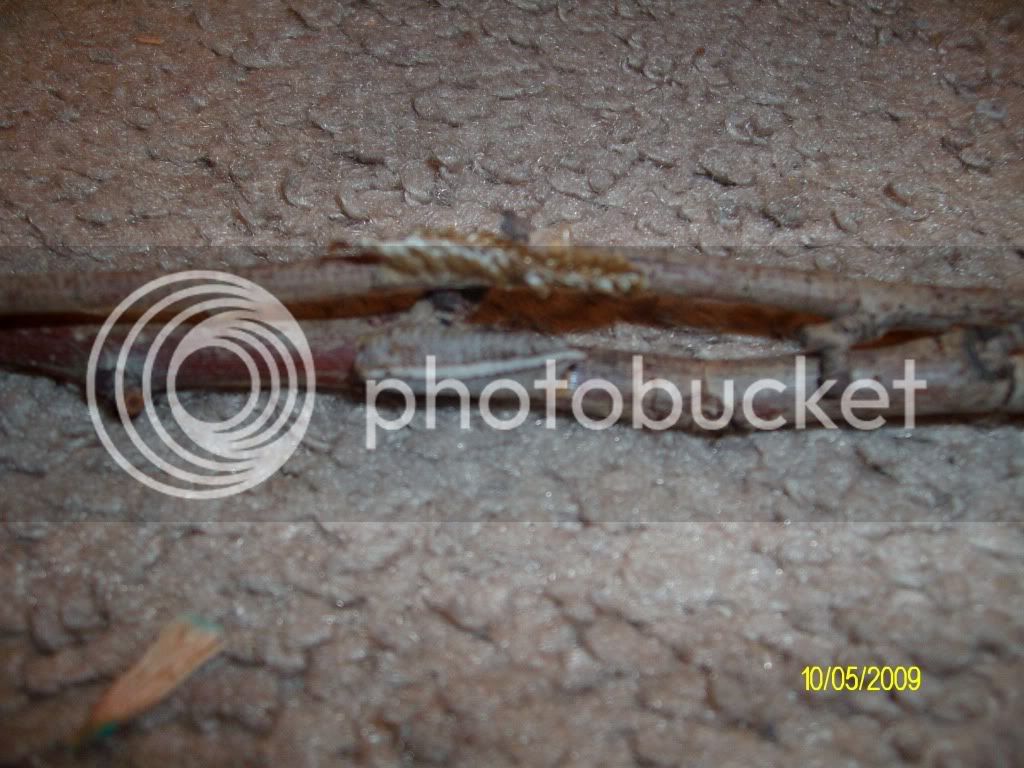



Last edited by a moderator:

$13.99 ($0.44 / Ounce)
Fresh Fruit Fly Culture (Drosophila Hydei) - Praying Mantis Mantid Frog Lizard Food - 32oz Cup
Surmen Legacy

$13.19 ($13.19 / Count)
Butterfly Breeding Net Folding Butterfly Habitat Cage White Butterfly Mesh Cage for Kid Garden Science Education Tool 40x40x60cm Butterfly Cage
Hubeichunliangnongyefazhanyouxiangongsi

$14.79 ($0.01 / Count)
$15.99 ($0.02 / Count)
BASSETT'S CRICKET RANCH 1000 Live Mealworms
Gimminy Crickets & Worms

$13.99 ($223.84 / lb)
Surmen Legacy Freshly Started Wingless Drosophila Melanogaster Fruit Fly Culture
Surmen Legacy

$16.99 ($16.99 / Count)
Josh's Frogs Freshly Started Flightless Drosophila Hydei Fruit Fly Culture
Josh's Frogs

$34.99
$39.99
RESTCLOUD 30" Large Monarch Butterfly Habitat Cage, Outdoor Insect Mesh Cage Terrarium 16.5" x 16.5" x 30"
Restcloud

$3.19 ($42.53 / lb)
$6.09 ($81.20 / lb)
Fluker's Gourmet Canned Food for Reptiles, Fish, Birds and Small Animals, Black, Mealworms 1.23 Ounce (Pack of 1)
Amazon.com

$39.95 ($1.25 / Ounce)
Creation Cultivated 32oz Fruit Fly Culture - Live Feeder Insects for Praying Mantis, Jumping Spiders, Geckos, Lizards, Dart Frogs (Drosophila Hydei Flightless)
Creation Cultivated

$20.99 ($20.99 / Count)
Jumping Spider Enclosure (4.7"x3.9"x7.8"), Spider Terrarium, Praying Mantis Habitat, Suitable for Small Arboreal Reptiles, Mantises, Spiders, and Other Invertebrates
Jiara Electronics

$18.99 ($2.12 / Ounce)
Josh's Frogs Producing Wingless Drosophila Melanogaster Fruit Fly Culture
Josh's Frogs

$13.53
Butterfly Breeding Net, Folding Butterfly Habitat Cage White Butterfly Mesh Cage for Kid Garden Science Education Tool 40x40x60cm
enshishiqiannanwangluoyouxiangongsi
If you don't see it then I would think it was something else. If it came out of it in an enclosed space I would think you would be able to find it.I don't know. I looked inside the container and I couldn't find any maggots or pupae things. All I saw were cricket parts littered here and there. I went back again today and saw nothing. Oh and just another side note. That same mantis when I caught it, "laid" two ooths. One was some small thing and the other was this: Obviously different than the standard I. oratoria ooth. This was laid a week before it died. The normal standard ooth (laid by a different female) is on the bottom.
superfreak
Well-known member
looks like it laid only the egg mass and no foam. i have my doubts about a parasitized mantid being able to lay even this sickly looking ooth as id assume the parasite would eat the eggs.
Ntsees
Well-known member
You know, if you manage to keep your mantids alive long enough, they'll start to lay ooths like that even when they are not parasitized. Mines usually start laying ooths like that if they survive until next year (naturally, they're supposed to die earlier).
Yep. I have had that before too. Don't think it has anything to do with this topic.You know, if you manage to keep your mantids alive long enough, they'll start to lay ooths like that even when they are not parasitized. Mines usually start laying ooths like that if they survive until next year (naturally, they're supposed to die earlier).
Ntsees
Well-known member
Ok, back to topic. Rick, have you killed the flies for display or are they still alive (if they are still alive, what are you planning to do?)? Have you managed to I.D. those flies as well?
Last edited by a moderator:
ismart
Well-known member
I'm also very curious on what this species of fly is called? Not to mention what other insect hosts these guy infect.
Still alive. I plan on finding out what they are but just haven't had time yet. Plan on it this weekend.Ok, back to topic. Rick, have you killed the flies for display or are they still alive (if they are still alive, what are you planning to do?)? Have you managed to I.D. those flies as well?
MantidLord
Well-known member
Okay, I see what you guys are saying. But that female was caught as an adult outside so I doubt that ooth is due to old age as it most likely wouldn't have made it that long in the wild. Though the parasite could have eaten the eggs, we don't know that for sure simply because most of the infected have either been sub-adult or non mated or unknown. Second, I can find no other explanation to that gaping hole appearing in her abdomen and the exact same and similar looking spot to the infected mantids. Furthermore, it is possible that the maggot pupated and my blind eyes just can't see them among the cricket parts.
Moving on, I look forward to seeing a comparison pic of the flies next to something we can all be familiar with. Also I still think this should be a sticky because 1) we don't know what the heck this is, 2) we don't know where it came from so it could have been brought over, 3) We don't know all what insects it infects, and 4) it seems like more than a coincidence that these things are popping up at the same time.
Moving on, I look forward to seeing a comparison pic of the flies next to something we can all be familiar with. Also I still think this should be a sticky because 1) we don't know what the heck this is, 2) we don't know where it came from so it could have been brought over, 3) We don't know all what insects it infects, and 4) it seems like more than a coincidence that these things are popping up at the same time.
I have had ooths like that from all kinds of mantids. It is not related to the parasite. It seems that every infected one I have ever found was a nymph late in the year. I agree the hole looks the same however you would see them in the bottom. If you haven't already then dump it all out and look through it. They are very obvious. This is nothing new, it is a fairly common occurrence. You act worried about this which I don't understand.Okay, I see what you guys are saying. But that female was caught as an adult outside so I doubt that ooth is due to old age as it most likely wouldn't have made it that long in the wild. Though the parasite could have eaten the eggs, we don't know that for sure simply because most of the infected have either been sub-adult or non mated or unknown. Second, I can find no other explanation to that gaping hole appearing in her abdomen and the exact same and similar looking spot to the infected mantids. Furthermore, it is possible that the maggot pupated and my blind eyes just can't see them among the cricket parts. Moving on, I look forward to seeing a comparison pic of the flies next to something we can all be familiar with. Also I still think this should be a sticky because 1) we don't know what the heck this is, 2) we don't know where it came from so it could have been brought over, 3) We don't know all what insects it infects, and 4) it seems like more than a coincidence that these things are popping up at the same time.
MantidLord
Well-known member
I'm far from worried, as my population isn't fed on wild feeders so I know that they won't be infected. I'm just extremely curious is all. I didn't know it was so common because when I look through the health section, I see nothing talking of the sorts, maybe the horse hair worm but that's all. Especially considering that this is by far one of the largest threads in this section (and possibly the whole mantis section) on this forum currently. And if it's so common, why is it that it's not Identified yet. But regardless of all that, my individual may not have been infected, in fact I hope it wasn't. But keep in mind that Joosa put a pic of an adult oratoria that was infected. So it probably doesn't just infect nymphs. I would guess it depends on when the mantis was infected itself.I have had ooths like that from all kinds of mantids. It is not related to the parasite. It seems that every infected one I have ever found was a nymph late in the year. I agree the hole looks the same however you would see them in the bottom. If you haven't already then dump it all out and look through it. They are very obvious. This is nothing new, it is a fairly common occurrence. You act worried about this which I don't understand.
And by the way, I'm not trying to offend anyone, I just want to be clear. And it seems the only thing pointing my mantis away from having been infected is the lack of the parasite, which is understandable but hey, some things can't be explained.
Last edited by a moderator:
Feeding on wild feeders would have nothing to do with this particular case. I have mentioned these type parasites many times because I woudl find the infected mantids when I was a kid. I am sure these are known parasites. I have not id'd the flies but I will give it a go. They are very unremarkable looking little flies.I'm far from worried, as my population isn't fed on wild feeders so I know that they won't be infected. I'm just extremely curious is all. I didn't know it was so common because when I look through the health section, I see nothing talking of the sorts, maybe the horse hair worm but that's all. Especially considering that this is by far one of the largest threads in this section (and possibly the whole mantis section) on this forum currently. And if it's so common, why is it that it's not Identified yet. But regardless of all that, my individual may not have been infected, in fact I hope it wasn't. But keep in mind that Joosa put a pic of an adult oratoria that was infected. So it probably doesn't just infect nymphs. I would guess it depends on when the mantis was infected itself. And by the way, I'm not trying to offend anyone, I just want to be clear. And it seems the only thing pointing my mantis away from having been infected is the lack of the parasite, which is understandable but hey, some things can't be explained.
Do you think a rogue cricket got a hold of your mantis? I always hear people talking about crickets eating on mantids though I have not seen it personally.
Last edited by a moderator:
MantidLord
Well-known member
Okay, for some reason I was stuck on the idea of the parasite being transferred through food, sorry about that. I just think it's interesting how you always find them (among other members) but then other members don't. I'm wondering if it's a climate thing or what. I just know that new members and hobbyists will come in contact with some parasite and it may be useful if we have a thread so they can easily refer to, reassuring them that it's common and so forth.Feeding on wild feeders would have nothing to do with this particular case. I have mentioned these type parasites many times because I woudl find the infected mantids when I was a kid. I am sure these are known parasites. I have not id'd the flies but I will give it a go. They are very unremarkable looking little flies.Do you think a rogue cricket got a hold of your mantis? I always hear people talking about crickets eating on mantids though I have not seen it personally.
As far as the rogue cricket, no the container was empty and the only thing moving when I saw the mantis two hours later, was the "breathing" abdomen of a cricket that was previously devoured. It flashed my mind that the cricket came out of the mantis but then I regained intelligence and decided that wasn't the case. But I must say that that mantis did seem sluggish before the incident which is exactly why I used it to take that picture with the wings (because me taking that picture was for a completely different purpose). And you can see the black mark on the abdomen too. I don't know if it has any correlation with what happened but those are just the facts. I too have never had a cricket eat a mantis even during molts (though I know it's possible).
am sure that other insects get infected just as much as the mantis like katydids or crickets or giant grasshoppers besides just the mantis but also wonder if since the cold weather is coming could some of these so called parasitic flies lay their eggs on tree bark or anything to be overwintered if thats even a possibility for the next season!
































